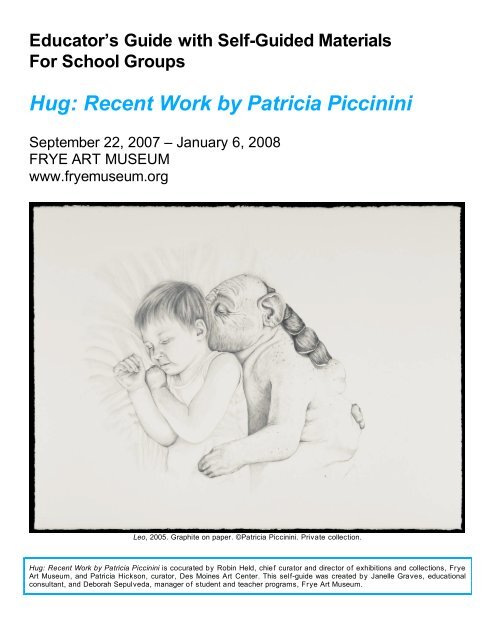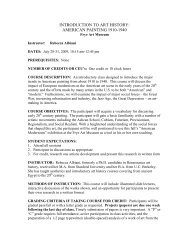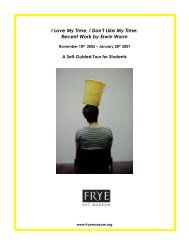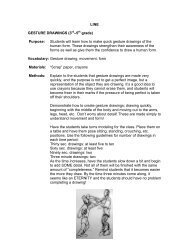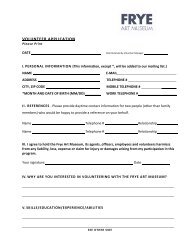Hug: Recent Work by Patricia Piccinini - Frye Art Museum
Hug: Recent Work by Patricia Piccinini - Frye Art Museum
Hug: Recent Work by Patricia Piccinini - Frye Art Museum
Create successful ePaper yourself
Turn your PDF publications into a flip-book with our unique Google optimized e-Paper software.
About the <strong>Art</strong>workThe following is background information about the artworks featured in the Gallery Activities.STOP #1Progenitor (for the Leadbeater’s Possum), 2005.Silicone, fiberglass, leather, plywood and hair, 2 parts.©<strong>Patricia</strong> <strong>Piccinini</strong>. Courtesy of the artist and Yvon Lambert New York.Offspring (for the Leadbeater’s Possum), 2005.Silicone, fiberglass, leather, plywood and hair, 2 parts.©<strong>Patricia</strong> <strong>Piccinini</strong>. Courtesy of the artist and Yvon Lambert New York.Some things, once done, are not easily undone. We might recognize later that weshould not have done them in the first place, however undoing them is not so easy.Like an egg, which once broken cannot be unbroken, when something is created, it isdifficult to contain. This stands as much for a work of art as it does for a geneticallymodified creature. 3<strong>Patricia</strong> <strong>Piccinini</strong>From her series Nature’s Little Helpers, these sculptural creatures were created to protect an existingendangered animal, the Leadbeater’s Possum. Once thought extinct, the small Leadbeater’s Possum’s survivalnow depends on its ability to find suitable hollow-bearing trees in which to nest. However, the ash forests itrelies upon are in short supply due in large part to excessive timber harvesting. <strong>Piccinini</strong>’s imagined speciesdirectly addresses this challenge. Designed with oversized incisors, it is physically equipped to shred bark andhollow out the trunks of trees to provide the living space for its near extinct relative.At its core, <strong>Piccinini</strong>’s artwork is about good intentions or, more specifically, doing the wrong thing for the rightreason. Can we use technology to solve environmental problems? Should we try to preserve, create or evenclone species rather than change human behavior? Who is responsible once an action is taken? Though wellmeaning,past experiences have shown us that scientific intervention into the environment often results in longlasting,even irreversible outcomes.Did You Know?<strong>Piccinini</strong>’s art explores the unintended results of human intervention into the natural world. She relates herconcept of “doing the wrong things for the right reasons” to a cautionary tale from early-twentieth centuryAustralia when scientists introduced, with unexpected results, the cane toad into the wild to eliminate canebeetles that were destroying valuable sugarcane crops. The toad killed not only the beetles, but many othernative species, and due to its increasing numbers, it continues to threaten Australian indigenous animalpopulations.In recent months a similar man-made environmental disaster was reported here in America. In 1972 as many astwo million tires were placed off the coast of Fort Lauderdale, Florida with the intention to create an artificialreef that would attract a rich variety of marine life. Now, twenty-five years later, little sea life has formed, theocean floor is littered with a path of tires, the length of thirty-one football fields, which are blocking coral growthand devastating marine life. This well-intentioned attempt to create the world’s largest artificial tire reef is nowconsidered an ecological disaster.3
STOP #2Bodyguard (for the Golden Helmeted Honeyeater), 2004.Silicone, fur, acrylic resin, timber, DVD, and monitor.©<strong>Patricia</strong> <strong>Piccinini</strong>. Private collection.Bodyguard, from the Nature’s Little Helpers series, is imagined as a protector of the Golden HelmetedHoneyeater or “HeHo,” a small, beautifully colored endangered bird, native to Australia (pictured on the videomonitor across from the sculpture). In 2004 there were only fifteen pairs of the bird left in the wild. At present,captive breeding programs are in place to keep the bird from extinction.<strong>Piccinini</strong> designed the Bodyguard to help protect the HeHo from human encroachment. Its long arms allow themonkey-like Bodyguard to swing quickly from tree to tree scaring away the HeHos’ predators. She also took intoaccount the HeHos’ eating habits: the Bodyguard’s sharp incisors can easily release the tree sap that HeHosfeed upon.The Nature’s Little Helpers series asks the viewer to consider the following questions: How far will we go to undo the damage we have done to the environment? Is it a good idea to create new life to help an endangered animal? What is the relationship between the creature and its creator? Who is responsible for the creature once it is created?4
STOP #3Arcadia (The rapid proliferation of these creatures seems a small price to Domain (While the alpha male does maintain a strong hierarchy,pay for the increase in Honeyeater numbers since their introduction.), 2005 juveniles are free to playfully interact.), 2005C-type photograph. ©<strong>Patricia</strong> <strong>Piccinini</strong>. Courtesy of the artist and Yvon C-type photograph. ©<strong>Patricia</strong> <strong>Piccinini</strong>. Courtesy of the artist and YvonLambert New York.Lambert New York.Encroachment (A typical family group with an infant have infestedthis construction site.), 2005. C-type photograph. ©<strong>Patricia</strong> <strong>Piccinini</strong>.Courtesy of the artist and Yvon Lambert New York.Thunderdome (It is possible that these two females are attractedto the noise and smell of the drag racing.), 2005. C-type photograph.©<strong>Patricia</strong> <strong>Piccinini</strong>. Courtesy of the artist and Yvon Lambert New York.<strong>Piccinini</strong> further explores the impact of the Bodyguard species in her narrative photographs, envisioningpossible relationships that might result if her creatures were introduced into our world.No visible sense of fear exists in <strong>Piccinini</strong>’s imagined contemporary community that lives side-<strong>by</strong>-side with herBodyguard species. The narrative photographs depict the Bodyguards in a variety of environments fromArcadia, where they frolic in the wilds, to Domain, where a group of young Bodyguards are seen playing on apile of construction debris while the alpha male keeps watch. In Encroachment, a creature approaches ahuman worker at a home construction site, while in Thunderdome, the Bodyguards participate as spectators ata drag-racing event. The Bodyguard was created to help the Golden Helmeted Honeyeater, or the HeHo. Isthere any evidence of the creature helping the HeHo in these photographs or have they simply become a part ofthe community?Accompanied <strong>by</strong> descriptive captions, the group of photographs take the form of a “mockumentary” that tells thestory of the Bodyguards’ population explosion and movement from their “natural” habitat in lush forests to thesuburban neighborhoods of Melbourne, where they are said to be merely “tolerated” <strong>by</strong> humans and caninesalike. The scenes bring to mind the cane toad infestation discussed previously. If introduced, there must be aplace in the world to welcome the creations. Again, accountability and responsibility for the results of scientificcreations and interventions remain a constant theme. Who is responsible? What happens to these creaturesonce the environmental problem is addressed?5
STOP #5Leather Landscape, 2003Silicone, acrylic, human hair, leather, clothing, and wood©<strong>Patricia</strong> <strong>Piccinini</strong>. Private collection.My interest here again is in our relationship to the animals and creatures we maycreate. In this work, you can series of humanoid, transgenic creatures, based on theAfrican Meerkat. They have a very beautiful environment to live in. I gave them whiteleather because both it and they are fragile. There is also an explicit interactionbetween the creatures and humans in the form of a little toddler, who is looking at thecreature the same way the creature is looking at her, with real curiosity. A toddlerdoes not know that they are made-up creatures. Everything is strange to her, buteverything is accepted. I guess in a way this work is about the idea of evolution, andhow we can now change the way evolution is going. The question is whether 'humanassisted' evolution is any different to 'natural' evolution. 6<strong>Patricia</strong> <strong>Piccinini</strong>Leather Landscape stages a meeting between a family of human-animal hybrids and a human toddler in whichthe girl and one of the creatures approach each other with an open curiosity. The hybrids, like the real-lifemeerkats they resemble, display a strong sense of communality: at the top of the structure, a male standsupright with wide, alert eyes, demonstrating his role as the group’s watchman; below him, a female cares forseveral babies; and opposite, a creature embraces his companion. The relationships depicted in LeatherLandscape emphasize the emotional bonds and familial tendencies shared <strong>by</strong> both humans and animals. Theseimagined creatures are presented as ordinary beings capable of loving and playing.Did You Know?Unfortunately for meerkats, they are a tasty treat for larger carnivores, especially jackals, eagles, and falcons.However, meerkats have developed a way to forage in relative safety. Adults will take turns acting as guard sothat the others can safely look for food. The guard climbs to the highest rock, termite mound, or bush he or shecan find, stands upright on two legs, and then announces the beginning of guard duty with a specialized call.Meerkats also share the duty of raising the babies, called pups. The mother will need to spend time foragingfood in order to supply her pups with milk, so other females and males will stay behind to care for and protectthe young.For more info on meerkats visit the San Diego Zoo’s website at http://w w w.sandiegozoo.org/animal<strong>by</strong>tes/tmeerkat.htmland watch Animal Planet’s, “Meerkat Manor” –http://animal.discovery.com/fansites/meerkat/meerkat.html.7
Pre-Visit ActivitiesElementary Discuss endangered species and the idea of extinction with your students. Discuss the reasons why animals are endangered or extinct. Ask students if they have ever seen a non-domesticated animal around their neighborhood or in thecity. Discuss why they think these animals may be in the city rather than in the woods. Ask students if they could create an animal to help protect endangered animals, what would it look like?What would it be able to do?Middle & High School Discuss contemporary art and the importance of the role of the viewer. Have the students read the self-guided materials. In small groups, have them discuss the materials andcreate a list of questions they have about the artwork. Ask students if they could create an animal to help protect endangered animals, what would it look like?What would it be able to do?We also encourage teachers and students to review <strong>Patricia</strong> <strong>Piccinini</strong>’s artwork <strong>by</strong> visiting her website at:http://w w w.patriciapiccinini.net/9
Back at SchoolThe exhibition, which provokes discussion about the complex, technologically advanced world in which we live,is appropriate for classes studying the intersection of art, technology, and society; endangered species and theenvironment; and the visual arts, especially sculpture and digital media. The artwork also addresses thefollowing four themes: empathy and responsibility, our animalness (what it means to be human), families, andthe idea of the natural environment (what is considered natural now).Elementary Re-visit the idea of extinction and endangered species from the pre-visit activities. Look at the list ofendangered and threatened species at the U.S Fish and Wildlife Service Web site –http://ecos.f ws.gov/tess_public/SpeciesReport.do?null. Select one animal from the list and write threeparagraphs about the animal or prepare a short presentation. Consider the following questions:•What is the animal?•Where can it be found?•Why is it threatened?•What is, or is not, being done to protect it?•Should the animal be preserved? Why or why not?•Are we responsible for preserving nature? Why or why not? What if we could create an animal to help protect these endangered animals? What would it look like?What would it have to be able to do? Have the student create an imaginary animal to protect theendangered or extinct animal. Consider having students choose from various mediums like drawing,painting, sculpture, or computer generated-creatures. Think about what Seattle looked like before people started developing it. What changes have been madesince then? How might these changes have affected animals and their natural habitats?Middle & High School Stage a debate on the topic: Why are we trying to preserve, breed, or even clone species rather thanchanging human behavior? Explore artists and literature that <strong>Patricia</strong> <strong>Piccinini</strong> identifies with such as Eric Swenson, Roxy Paine,Berlinde de Bruyckere and David Cronenburg. Check out the book, Never Let Me Go, <strong>by</strong> Kazuo Ishiguro. Choose an issue of personal relevance and create a work of art in any form or combination of formsthat comments on the issue you selected. When explaining the fact that many of her artworks are actually made <strong>by</strong> other specialists, <strong>Piccinini</strong> said,“I tell people straight out that I conceive the work and then bring together the pieces. If I didn’t have greatpeople working on the projects, it wouldn’t work. I don’t want the ideas to be limited <strong>by</strong> what I canphysically do. The ideas come first.” 8 In other words, while she develops the concept of all herartworks, in some cases her art might be made entirely <strong>by</strong> another hand.<strong>Work</strong> in groups to explore other artists, musicians, or dancers who work collaboratively to completetheir ideas.•What are the benefits and drawbacks to working in a group? Why do these artists choose towork collaboratively? Is there a lead artist and a team of workers? What is the role of eachperson? In the end, who gets recognized as the artist of the artwork? Why? What are thepotential complications in sorting out who is the leader/creator and worker/assistant?10
Gallery Activities for Elementary School StudentsSTOP #1The artworks presented in the first four exhibition stops are part of <strong>Piccinini</strong>’s Nature’sLittle Helpers series. In this series, the artist explores the creation of imaginaryanimals designed to protect real-life endangered animals. Why do you think these creatures were created? What is the relationship between the women and the creature? Do you think that they are embracing in afriendly hug or an attack? Why would you create new life?STOP #2 The Bodyguard opens his mouth wide, showing off his sharp teeth, perhaps to scareaway a predator of the HeHo. Look carefully. What other clues can you see that may helpyou understand the purpose of the Bodyguard? Do you think it is a good idea to create a creature to help an endangered animal? Why?Why not?STOP #3 What is going on in these photographs? Do you think the Bodyguard looks at home in these photographs? What type of creature would you create to save an endangered animal?What special features or traits would it have to have in order to protectyour animal? Who is responsible for the creature once it is created? Draw a picture of what your new creature would look like.STOP #4 What is the relationship between the child and the creature?11
________________________________________________________________________________________________________________________________________________________________________________________________________________________________________________________________________STOP #5 What relationships do you notice between these creatures? Describe the family:________________________________________________________________________________________________________________________________________________________________________________________________________________________________________STOP #6 These are ba<strong>by</strong> motorcycles. How do you think they will change as they grow up? What kind of personalities do you think they have?________________________________________________________________________________________________________________________________________________________________________________________________________________________________________Before You Leave the <strong>Museum</strong> Choose an artwork in the galleries that is not discussed in the self-guide, and give yourself “permission” toconstruct your own meaning. Feel free to work alone or in groups. Ask yourself: What’s going on in thisartwork? Write down your ideas and when you are back at school share them with your classmates.________________________________________________________________________________________________________________________________________________________________________________________________________________________________________________________________________________________________________________________________________________________________________________________________________________________________________________________________________________________________________________________________________________________________________________________________________________________________________________________________________________________________________________________________12
Gallery Activities for Middle & High School StudentsSTOP #1The artworks presented in the first four exhibition stops are part of <strong>Piccinini</strong>’s Nature’sLittle Helpers series. In this series, the artist explores the creation of imaginary animalsdesigned to protect real-life endangered animals. These man-made creatures are intended to help the endangered possum survive. Do you think this is a goodreason to create a new life form? Why? Why not? Why would you create a new life? What do you think the relationship between its creator and the creaturewould be like? What questions about nature, technology, and their interrelationship does this artwork raise for you?STOP #2 Do you think the Bodyguard is able to protect the endangered HeHo? Do you think the animal is controllable? Why? Why not? Describe the setting. Why do you think the artist chose this futuristic, man-made setting?__________________________________________________________________________________________________________________________________________________________________________________________________________________________________________________STOP #3 Consider each of the photographs, and discuss what is going on ineach. What questions do these images raise for you? Accountability and responsibility for the result of human interventionsare a constant theme in <strong>Piccinini</strong>’s artwork. Who is responsible? Whathappens to these creatures once the environmental problem isaddressed? How do you think these new animals might affect otheranimals or plant life?________________________________________________________________________________________________________________________________________________________________________________________________________________________________________________________________________________________________________________________________________________________________________________________________________________________________________________________________________________________________________________________________________________________________________________________________________________________________________13
STOP #4 How does the relationship between the child and the creature make you feel? What questions does this image raise for you? How does the use of drawing influence your perception of the work?_______________________________________________________________________________________________________________________________________________________________________________________________________________________________________________________STOP #5 Describe the relationships between the creatures in this artwork.______________________________________________________________________________________________________________________________________________ What does the environment of these humanoid creatures tell us about them? What questions about humans and their relationship to animals does this sculpture raise for you?________________________________________________________________________________________________________________________________________________________________________________________________________________________________________________________________________STOP #6 How is technology part of your daily life?_________________________________________________________________________ What questions about humans and their relationship to technology and daily life doesthis sculpture raise for you?________________________________________________________________________________________ What does the customizing of these Cyclepups tell us about the owner?________________________________________________________________________________________ Before You Leave the <strong>Museum</strong>Choose an artwork in the galleries that is not discussed in the self-guide, and give yourself “permission” toconstruct your own meaning. Feel free to work alone or in groups. Ask yourself: What’s going on in thisartwork? Write down your ideas and when you are back at school share your ideas with your classmates.14
<strong>Patricia</strong> <strong>Piccinini</strong> Quotes:1<strong>Patricia</strong> <strong>Piccinini</strong>, In Another Life exhibition catalogue, Wellington City Gallery, Wellington, NZ, 2006.http://www.patriciapiccinini.net/essay.php2 Daniel Palmer interview with <strong>Patricia</strong> <strong>Piccinini</strong> and Peter Hennessey, 2001.http://www.patriciapiccinini.net/essay.php?id=63 <strong>Patricia</strong> <strong>Piccinini</strong>, Unbreaking Eggs. Roslyn Oxley9 Gallery, Sydney, Australia, September 3, 2005.http://www.roslynoxley9.com.au/news/releases/2005/09/03/95/4 Julie Copeland interview with <strong>Patricia</strong> <strong>Piccinini</strong>. Radio National’s Sunday Morning program, Australia, May 26, 2002.http://www.abc.net.au/arts/visual/stories/s597714.htm5 <strong>Patricia</strong> <strong>Piccinini</strong>, <strong>Recent</strong> Drawings. Roslyn Oxley9 Gallery, Sydney, Australia, October 5, 2006.http://www.roslynoxley9.com.au/news/releases/2006/10/05/115/6 <strong>Patricia</strong> <strong>Piccinini</strong> public lecture. Tokyo National University of Fine <strong>Art</strong>s and Music. December 8, 2003.http://www.patriciapiccinini.net/essay.php?id=277 <strong>Patricia</strong> <strong>Piccinini</strong>, Nature’s Little Helpers exhibition catalog, Robert Miller Gallery, New York, 2005.http://www.patriciapiccinini.net/natureslittlehelpers/index.php?show=cv&subtype=cv&textfile=nlh.htm8 Daniel Palmer interview with <strong>Patricia</strong> <strong>Piccinini</strong> and Peter Hennessey, 2001.http://www.patriciapiccinini.net/essay.php?id=69 <strong>Patricia</strong> <strong>Piccinini</strong>, Nature’s Little Helpers <strong>Art</strong>ist Statement.http://www.patriciapiccinini.net/natureslittlehelpers/index.php?show=cv&subtype=cv&textfile=nlh.htm10 <strong>Patricia</strong> <strong>Piccinini</strong>, Nature’s Little Helpers <strong>Art</strong>ist Statement.http://www.patriciapiccinini.net/natureslittlehelpers/index.php?show=cv&subtype=cv&textfile=nlh.htmfryemuseum.org15


